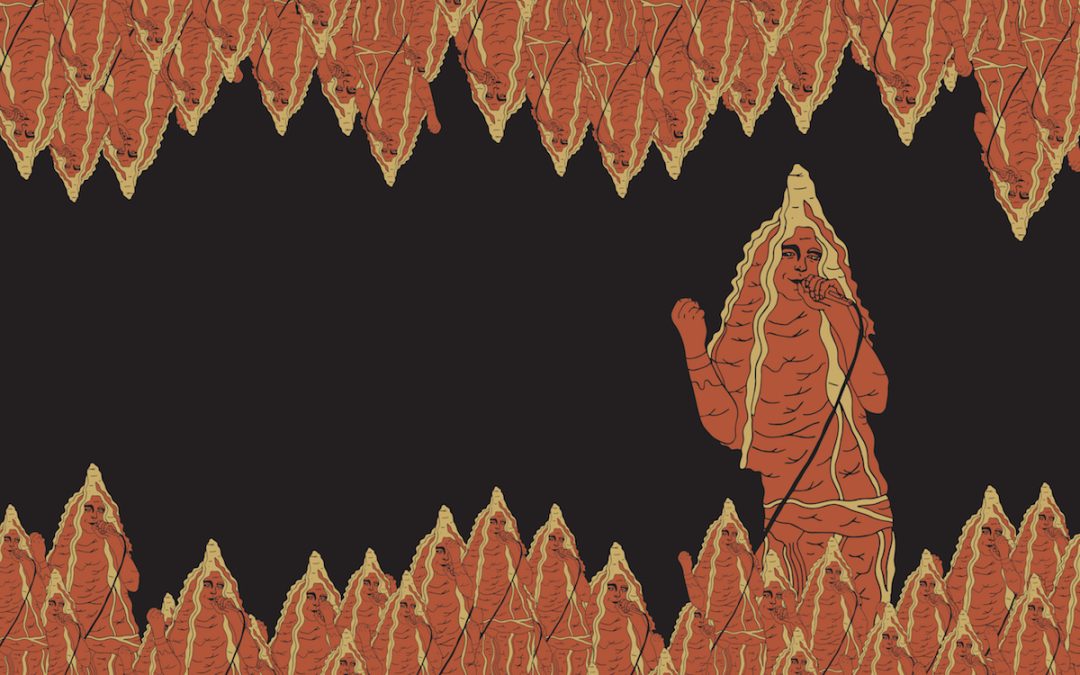Illustration by Mary Anne Carter.
Prior to a vacation centered around visiting my Southern belle girlfriend Mary Anne’s family, I imagined the state of Virginia as a series of covered bridges and water mills and some sort of taxidermy-laden, water mill-themed version of Japanese love hotels (since the state slogan is “Virginia is for lovers.”) Dixie Cavern, one of Mary Anne’s favorite diversions during college at Virginia Tech, wasn’t any of these things, though one of its featured geological formations, a stalagmite called the “Lone Soldier,” could provide great amusement to flexible, well-lubricated lover(s.)
While waiting for our tour to begin we lost ourselves in the truly fantastic, if deeply problematic, adjoining antiques mall. I bought a switch blade whose handle was carved from an antler, and a bundle of vintage pens. There were an alarming number of racist cookie jars and salt shakers (the kind disturbingly fashioned to resemble caricatures of servants and slaves of yesteryear) and a case of Nazi daggers.
Our tour group, led by a charismatic young guy with a blonde Beatles haircut, included only two people besides Mary Anne and our friend Kevin, a talkative middle-aged woman and a shy college student. They were understandably enthusiastic—the cavern was amazing. Previously the only cave I’d been in was one in the Cascades called “Jacob’s Crevice,” and in comparison to Dixie Cavern, it was less exciting than its title implies. Massive Dixie, whose entire interior was sculpted by glacial runoff to resemble a baroque pipe organ, was discovered by two kids who were out hiking when their dog fell into a mysterious hole in the ground. After describing to the farmer who owned the land where they’d retrieved their dog, the three spent years exploring the cavern and began hosting tours.
The tour itself could have been written by the guys who found the cavern eighty years ago. Mary Anne and Kevin exchanged wide-eyed glances when our guide showed us a stalagmite called “Chief One-Feather.” “They say all this water dripping from the ceiling is from his rain dances,” the guide told us, “and look there,” he gestured to a lumpy column of limestone, “He even brought along his totem pole.” There was a story about another formation, supposedly a witch who was turned to stone by fairies when she tried to enter their kingdom. Somehow this was just as sad and weird to me as Chief One-Feather. As the stories accrued, my bafflement turned into horror, a claustrophobia that had nothing to do with the enclosed space. How did people still think this way? The guide flipped on a light and a pool of water inside a rock resembling a geode mirrored the ceiling’s chandelier of delicate, nearly transparent stalactites—the fairy kingdom. Mary Anne and I squeezed each other’s hands, in awe of nature’s ability to blaze through the patina of human icky-ness.
Most of the remainder of the tour was related to Led Zeppelin. The guide urged us not to etch our names into a soft wall of excavated clay, then pointed out his own Led Zeppelin homage in the corner. The older woman’s eyes lit up—she had seen the band multiple times, and once, she said, she almost met Robert Plant when he passed her on a staircase but she was too shy to approach him. The guide was thoroughly impressed.
The finale of the tour was lights out for 30 seconds of total darkness in the largest chamber of the cavern. Of course, seconds after the guide hit the lights, Mary Anne made a fart sound so loud it reverberated, reminding me that falling in love is not a discrete event but a process involving many (fart sounds.)
On our way back through the parking lot, the tour guide said something like “Hey little buddy!” to a little boy with a green mohawk, who yelled, “CAN I BITE YOU?”
[wc_spacing size=”40px”]
[wc_divider style=”solid” line=”single” margin_top=”” margin_bottom=””]

